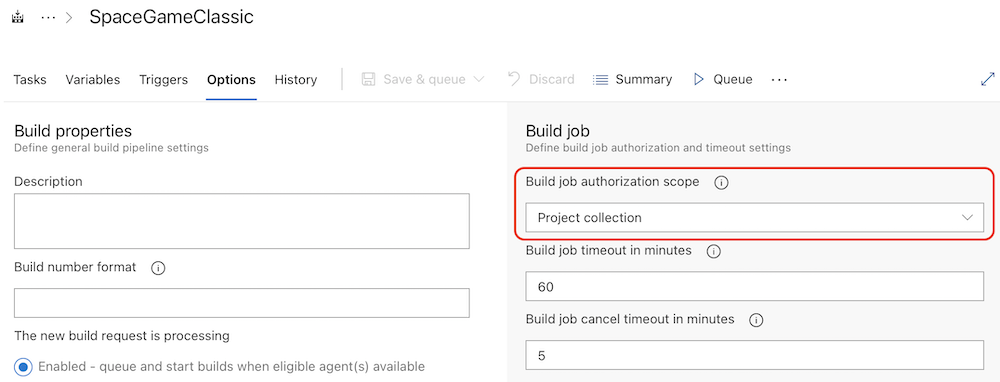Secure access to Azure Repos from pipelines
Azure DevOps Services | Azure DevOps Server 2022 | Azure DevOps Server 2020
Your repositories are vital for your business success as they house the code powering your operations. Access to repositories should be carefully controlled. This article guides you on enhancing Build pipeline and Classic release pipeline security when accessing Azure Repos to mitigate the risk of unauthorized access.
To ensure secure access to Azure repositories, enable the following toggles:
- Limit job authorization scope to current project for non-release pipelines
- Limit job authorization scope to current project for release pipelines
- Protect access to repositories in YAML pipelines
Basic process
The following steps to secure your pipelines are similar across all pipelines:
- Identify the Azure Repos repositories that your pipeline requires access to within the same organization but across different projects.
Do so by inspecting your pipeline or enable Limit job authorization scope to current project for (non-)release pipelines and note which repositories your pipeline fails to check out. Submodule repositories might not show up in the first failed run. - Grant the pipeline's build identity access to that project for each project that contains a repository your pipeline needs to access.
- Grant the pipeline's build identity Read access to that repository for each repository your pipeline checks out.
- Grant the pipeline's build identity Read access to that repository for each repository that is used as a submodule by a repository your pipeline checks out and is in the same project.
- Enable Limit job authorization scope to current project for non-release pipelines, Limit job authorization scope to current project for release pipelines, and Protect access to repositories in YAML pipelines.
Build pipelines
To illustrate the steps to take to improve the security of your pipelines when they access Azure Repos, we use the following example.
- Assume you're working on the
SpaceGameWebpipeline hosted in thefabrikam-tailspin/SpaceGameWebproject, in theSpaceGameWebAzure Repos repository. - Your
SpaceGameWebpipeline checks out theSpaceGameWebReactrepository in the same project, and theFabrikamFiberandFabrikamChatrepositories in thefabrikam-tailspin/FabrikamFiberproject. - The
FabrikamFiberrepository uses theFabrikamFiberLibrepository as a submodule, hosted in the same project. - The
SpaceGameWebproject's repository structures look like in the following screenshot.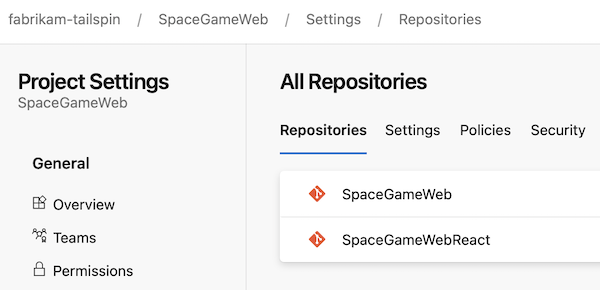
- The
FabrikamFiberproject's repository structures look like in the following screenshot.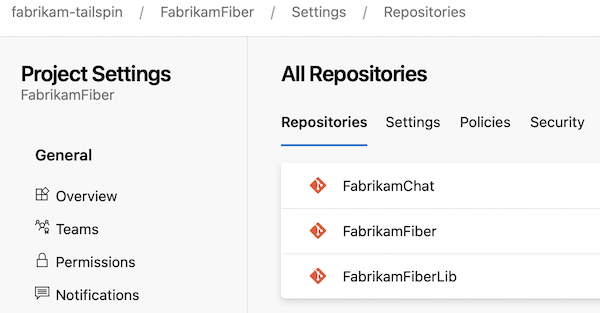
- Imagine your project isn't set up to use a project-based build identity or to protect access to repositories in YAML pipelines. Also, assume you already successfully ran your pipeline.
Use a project-based build identity for build pipelines
During pipeline execution, an identity gets used to access resources, such as repositories, service connections, and variable groups. Pipelines can utilize two types of identities: project-level and collection-level. The former prioritizes security, while the latter emphasizes ease of use. For more information, see scoped build identities and job authorization scope.
For enhanced security, use project-level identities when you run your pipelines. These identities can only access resources within their associated project, minimizing the risk of unauthorized access by malicious actors.
To configure your pipeline to use a project-level identity, enable the Limit job authorization scope to current project for non-release pipelines setting.
In our running example, when this toggle is off, the SpaceGameWeb pipeline can access all repositories in all projects. When the toggle is on, SpaceGameWeb can only access resources in the fabrikam-tailspin/SpaceGameWeb project, so only the SpaceGameWeb and SpaceGameWebReact repositories.
If you run our example pipeline, when you turn on the toggle, the pipeline fails, and the error logs tell you remote: TF401019: The Git repository with name or identifier FabrikamChat does not exist or you do not have permissions for the operation you are attempting. and remote: TF401019: The Git repository with name or identifier FabrikamFiber does not exist or you do not have permissions for the operation you are attempting.
To fix the checkout issues, follow the steps described in the Basic process section of this article.
Additionally, explicitly check out the submodule repositories, before the repositories that use them. In our example, it means the FabrikamFiberLib repository.
If you run our example pipeline, it succeeds.
Further configuration
To further improve security when you access Azure Repos, consider enabling Protect access to repositories in YAML pipelines.
Assume the SpaceGameWeb pipeline is a YAML pipeline, and its YAML source code looks similar to the following code.
trigger:
- main
pool:
vmImage: ubuntu-latest
resources:
repositories:
- repository: SpaceGameWebReact
name: SpaceGameWeb/SpaceGameWebReact
type: git
- repository: FabrikamFiber
name: FabrikamFiber/FabrikamFiber
type: git
- repository: FabrikamChat
name: FabrikamFiber/FabrikamChat
type: git
steps:
- script: echo "Building SpaceGameWeb"
- checkout: SpaceGameWebReact
- checkout: FabrikamChat
condition: always()
- checkout: FabrikamFiber
submodules: true
condition: always()
- script: |
cd FabrikamFiber
git -c http.extraheader="AUTHORIZATION: bearer $(System.AccessToken)" submodule update --recursive --remote
- script: cat $(Build.Repository.LocalPath)/FabrikamFiber/FabrikamFiberLib/README.md
- ...
Protect access to repositories in YAML pipelines
Azure DevOps provides a fine-grained permissions mechanism for Azure Repos repositories, in the form of the Protect access to repositories in YAML pipelines setting. This setting makes a YAML pipeline explicitly ask for permission to access all Azure Repos repositories, regardless of which project they belong to. For more information, see access repos. This setting doesn't affect checking out other types of repositories, such as GitHub-hosted ones.
In our running example, when this setting is turned on, the SpaceGameWeb pipeline asks permission to access the SpaceGameWebReact repository in the fabrikam-tailspin/SpaceGameWeb project, and the FabrikamFiber and FabrikamChat repositories in the fabrikam-tailspin/FabrikamFiber project.
When you run the example pipeline, it builds similar to the following example.
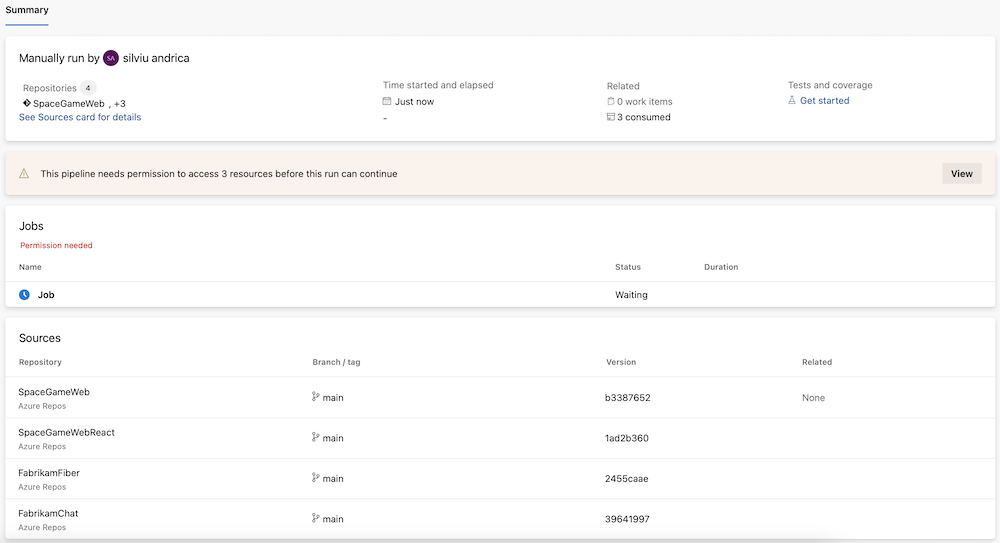
Grant permission to your pipeline repositories or resources.
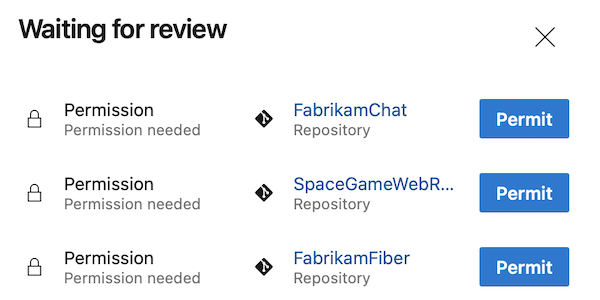
Your pipeline runs, but fails because it can't check out the FabrikamFiberLib repository as a submodule of FabrikamFiber. To solve this issue, explicitly check out the FabrikamFiberLib, by adding a - checkout: git://FabrikamFiber/FabrikamFiberLib step, before the -checkout: FabrikamFiber step.
The example pipeline succeeds.
Our final YAML pipeline source code looks like the following code snippet.
trigger:
- main
pool:
vmImage: ubuntu-latest
resources:
repositories:
- repository: SpaceGameWebReact
name: SpaceGameWeb/SpaceGameWebReact
type: git
- repository: FabrikamFiber
name: FabrikamFiber/FabrikamFiber
type: git
- repository: FabrikamChat
name: FabrikamFiber/FabrikamChat
type: git
steps:
- script: echo "Building SpaceGameWeb"
- checkout: SpaceGameWebReact
- checkout: FabrikamChat
condition: always()
- checkout: git://FabrikamFiber/FabrikamFiberLib
- checkout: FabrikamFiber
submodules: true
condition: always()
- script: |
cd FabrikamFiber
git -c http.extraheader="AUTHORIZATION: bearer $(System.AccessToken)" submodule update --recursive --remote
- script: cat $(Build.Repository.LocalPath)/FabrikamFiber/FabrikamFiberLib/README.md
Troubleshooting
Use the following solutions for any issues that arise.
You use git in command line to check out repositories in the same organization
For example, you're using - script: git clone https://$(System.AccessToken)@dev.azure.com/fabrikam-tailspin/FabrikamFiber/_git/OtherRepo/. The command fails when the Protect access to repositories in YAML pipelines setting is turned on.
To solve the issue, check out the OtherRepo repository using the checkout command, such as - checkout: git://FabrikamFiber/OtherRepo.
A repository is using another repository as submodule
Say one of the repositories your pipeline checks out uses another repository (in the same project) as submodule, as is the case in our example for the FabrikamFiber and FabrikamFiberLib repositories. Read more about how to check out submodules.
Furthermore, assume you gave the SpaceGame build identity Read access to this repo, but the checkout of the FabrikamFiber repository still fails when checking out the FabrikamFiberLib submodule.
To solve this issue, explicitly check out the FabrikamFiberLib, by adding a - checkout: git://FabrikamFiber/FabrikamFiberLib step before the -checkout: FabrikamFiber one.
Classic release pipelines
The process for securing access to repositories for release pipelines is similar to the one for build pipelines.
To illustrate the steps you need to take, we use a running example. In our example, there's a release pipeline named FabrikamFiberDocRelease in the fabrikam-tailspin/FabrikamFiberDocRelease project. Assume the pipeline checks out the FabrikamFiber repository in the fabrikam-tailspin/FabrikamFiber project, runs a command to generate public documentation, and then publishes it to a website. Additionally, imagine the FabrikamFiber repository uses the FabrikamFiberLib repository (in the same project) as a submodule.
Use a Project-based build identity for classic release pipelines
When a pipeline executes, it uses an identity to access various resources, such as repositories, service connections, variable groups. There are two types of identities a pipeline can use: a project-level one and a collection-level one. The former provides better security. The latter provides ease of use. Read more about scoped build identities and job authorization scope.
We recommend you use project-level identities for running your pipelines. By default, project-level identities can only access resources in the project of which they're a member. Using this identity improves security, because it reduces the access gained by a malicious person when hijacking your pipeline.
To make your pipeline use a project-level identity, turn on the Limit job authorization scope to current project for release pipelines setting.
In our running example, when this toggle is off, the FabrikamFiberDocRelease release pipeline can access all repositories in all projects, including the FabrikamFiber repository. When the toggle is on, FabrikamFiberDocRelease can only access resources in the fabrikam-tailspin/FabrikamFiberDocRelease project, so the FabrikamFiber repository becomes inaccessible.
If you run our example pipeline, when you turn on the toggle, the pipeline fails, and the logs tell you remote: TF401019: The Git repository with name or identifier FabrikamFiber does not exist or you do not have permissions for the operation you are attempting.
To fix these issues, follow the steps in the Basic process section of this article.
Our example pipeline succeeds.
